Our furry friends play an essential role in our lives. Dogs bring us so much joy – playing ball with them in the yard, or going on a walk, is a great way to spend the afternoon with your canine pal.
However, pets are like people, and they lose mobility with age. As your dog gets older, it may be at risk of losing its ability to walk correctly. Dogs with bad hips or lower backs can end up deteriorating rapidly over a few months.
It’s heartbreaking to watch your dog struggle with walking or standing up.
Fortunately, you can relieve some of the pain and discomfort your dog experiences with a dog wheelchair to support them while they walk around.
Dog wheelchairs are available online, but why go to the expense of buying a prefabricated model when you can build one yourself for a fraction of the cost.
Your dog won’t care whether you buy them a fancy prebuilt chair, or your design one at home and construct it yourself.
All your doggie cares about is walking at your side. The DIY dog wheelchair improves the quality of life for your pet. It takes a bit of time for your pooch to become accustomed to using the wheelchair.
However, after a few days, they’ll find it easy to use, and they’ll be walking alongside you around the block.
Take Note
A DIY dog wheelchair lets your dog recover mobility, restoring their sense of well-being. Dogs need to exercise, and if you don’t give them a walk, the condition may deteriorate further, forcing you to take them to the vet for assessment and possibly euthanasia.
In this article, we’ll give you everything you need to know about designing and building a DIY wheelchair for your dog.
What Kind of Mobility Issues Put Dogs in Wheelchairs?

There are several reasons why your dog might need a wheelchair. The most common issue is with aging. As your dog gets older, its skeleton starts to leech calcium and other critical nutrients, reducing bone density.
As a result of this process, your dog’s skeletal system begins to experience a decline.
It’s common for dogs to show signs of aging and arthritis as they get beyond 8 to 9-years old, depending on the breed.
Aging and arthritis can deteriorate your digs mobility quickly, resulting in them losing mobility in the back legs.
You might find that your dog has a tough time getting up, and they rely more on the front legs to handle the weight when standing.
The dog will shift the weight to the front legs to avoid the pain in the rear, resulting in other structural imbalances that hurt your dog.
Therefore, the best way to remedy the situation is to build your pet a dog wheelchair from scratch. The wheelchair supports the rear of your dog, taking the weight off the hips and the lower portion of the spine.
With a dog wheelchair, your pooch can enjoy walks, without the pain.
There are plenty of other issues that may cause a decline in your dogs’ mobility.
Amputation of a limb or multiple limbs may leave them unable to walk without the assistance of a wheelchair. Your dog might have to go in for hip surgery, and they’ll need a wheelchair in the post-recovery phase.
Neurological problems affecting your dog might cause them to lose mobility, and they’ll need a wheelchair to get around.
Genetics also plays a significant role in dogs losing mobility as they age.
Dogs that interbreed with family members will end up producing puppies that have health issues. When inbreeding results in health issues, one of the more common occurrences is problems in the hips.
The dog might not have a fully-formed hip socket, causing them to lose mobility early in life. Certain breeds, such as Labradors, are in high demand for pets.
Some private breeders might let inbreeding occur, resulting in genetically-deficient dogs predisposed to developing arthritis and mobility issues in the hips and the lower portion of the spine.
Take Note
If you’re getting a new dog, then make sure you purchase your pet from a breeder than can show you a proof of their breeding program.
Also Read: Best Senior Diet for Ageing Dogs
What Are the Key Features of a Pet Wheelchair?

beagle_yangsoon/Instagram
Building a DIY dog wheelchair isn’t as challenging as you think. All you need are some spare parts from a DIY hardware store and some basic tools.
Most DIY dog chairs feature design and construction with PVC pipes and joints.
The joints make it easy to construct a chair, allowing you to slot the frame into place. You’ll need some soft material for the shoulder harness, and a set of casters or wheels to suit the size of the wheelchair.
We recommend using large wheels, as they have an easier time navigating over rocks, bumps, and other debris in the path.
Some wheelchairs support the rear or front legs, and some that support both.
Depending on the health of your dog, you can decide on which model provides the best utility for your furry friend.
Two Wheels or a Quad-Chair?
To determine the level of support your pet dog needs, try this simple towel test:
There are two styles of dog wheelchairs – two-wheels, and quad versions. The quad versions look like mini carts, and they often feature a sling between the wheel axles to support the entire length of your dog’s body.
The 4-wheel quad carts often feature independent casters to allow for easy directional changes.
Quad wheelchairs are for dogs that are recovering from surgery or require more support due to the degradation of the front legs and hips. They provide more support. However, it might be harder for your dog to adjust to walking in the chair.
The two-wheel design is suit dogs that are having issues with either the front or back legs. In most cases, the front leg design for wheelchairs is for dogs that lost a leg to amputation. Rear wheelchairs are typically for dogs that experience aging problems and issues with a decline in skeletal health, such as arthritis and bad hips.
Also Read: How to Make DIY Dog Diapers
Can I Hurt My Dog Lifting them into the Chair?
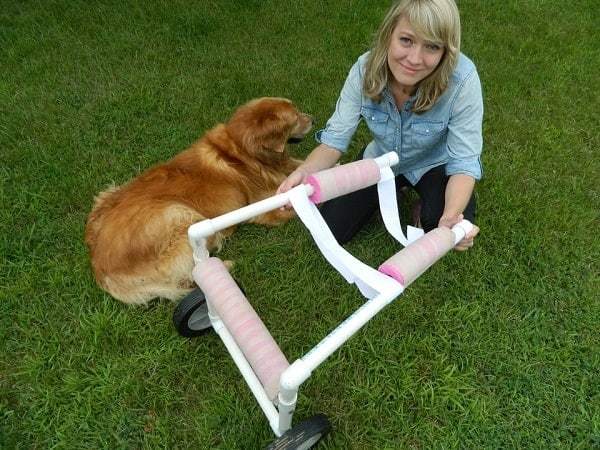
April Schultz / ForConstructionPros.com
Your dog needs a wheelchair that’s supportive and comfortable, or else they might try to get out of the chair, resulting in further injury.
Your DIY dog wheelchair should allow you to adjust it quickly, with removable wheels and components for easy replacement.
The first few times you attempt to get your pooch into the wheelchair, they may put up resistance. The chair is new to them, and they have no idea why you’re asking them to sit in it.
Take it step-by-step with your dog, and make sure you don’t force them into the situation. If your dog is showing signs of distress, abort the process, and let them out of the chair.
If your dog does put up resistance to the wheelchair, then calm them down with praise and a treat, then try again later. Take it slow, and don’t stress your furry friend.
Are there Wheelchairs for Large Breeds?
Dog wheelchairs are available in all types of sizes to suit any breed.
The best part about building a DIY chair is that you can customize it to your dog’s exact height and width. This customization allows for a comfortable and highly functional fit.
Provided you use the right materials, and follow the design instructions properly, you should have no trouble building a sturdy wheelchair for dogs that weigh up to 240-lbs.
How Do You Measure Your Dog for the Wheelchair?
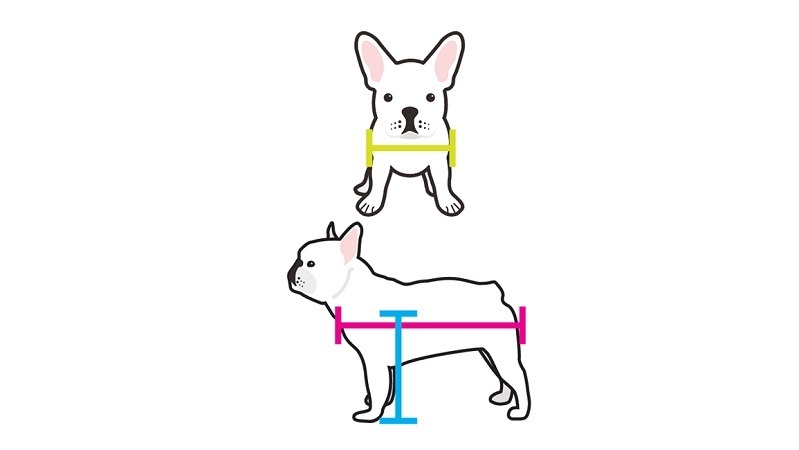
FiGO | Rear Support Pet Wheelchair by Rickee
Building a custom wheelchair for your dog from scratch requires a few measurements, some building materials, and a few simple tools. We recommend you use comfortable but supportive materials for the sling that don’t have much stretch.
Stretchy materials will give way, forcing a loss of support in the cradle that will hurt your dog.
You’ll need to measure your dog to start the process.
Here are the key measurements you need before you start the build.
- The back height measured from the floor to the top of the hips
- The length from the base of the tail to the shoulders
- The distance from the heels of the front paws to the toes on the back feet
- Measure the chest from behind the front legs
- The distance from the floor to the top of the shoulders
- Straight shoulder width (not curved)
- Straight hip-width (not curved)
- Measure from the floor to the groin
These measurements give you all the information you need to start building your doggie wheelchair. You’ll find that measuring your dog for a wheelchair is like fitting them for a new harness.
Designing and Building a Dog Wheelchair
Selecting the right model of the wheelchair for your pet is a critical part of the build process. Your dog needs a wheelchair that fits its lifestyle requirements.
Before you settle on a design, ask yourself why your dog needs a wheelchair. Do they have weakened back or front legs? Or maybe they have problems with both the front and the back legs?
The bigger the dog, the more durable your materials, and you’ll need thicker PVC pipes and bolts for the job. Building the best dog wheelchair depends on the materials you use and the plans you follow during your design.
Also Read: The Best Dog Ramps
What Materials Do You Need to Build a Dog Wheelchair?
Before you download any plans, its best to visit the hardware store and gather the materials you need for the job.
Here is a list of tools and materials you’ll need to build a wheelchair.
- PVC piping – use 1-inch pipe for small breeds, 2-inch pipe for medium-sized dogs, and 3-inch for large breeds
- Hacksaw and blades for cutting the PVC
- PVC joints, including bends and tees
- Comfortable, non-stretching fabric for the sling or seat
- A harness to secure your dog in the seated position
- Casters of wheels – the bigger, the better
Tips for Building Your Dog Wheelchair
We have some handy tips to help you with the build process. Our first idea is to use a PVC cutter if you have the budget for the tool. The PVC cutter makes trimming your PVC pipes effortless, and it's more accurate than using a handsaw.
These cutters are also available to rent from many plant-and-hire companies.
Most PVC pipes offer a snug fit. Therefore, in most cases, it’s not necessary to secure the frame using PVC glue, especially for small breeds.
However, if you have a large dog that weighs over 15-lbs, we recommend you glue the frame to prevent it from coming apart during longer walks.
Leaving the chair unglued makes it easy to strip to take with you on the road.
That’s an essential feature for larger designs. If you do decide to glue everything together, make sure you do a test run to see if everything fits together properly before you glue it up.
The wheels of the chair are a critical component.
Depending on the size and weight of your dog, you might need small or large wheels.
For small breeds like chihuahuas and poms, rollerblade or skateboard wheels work well, providing your dog with everything they need to move around comfortably.
For larger breeds, we like using cart-style wheels or small bicycle wheels.
The large wheels move over rocks and through ditches with ease, giving your dog more freedom to roam when they are in the park or on public land.
The sling is another critical part of the wheelchair. If you live in a warm climate, make sure you choose a breathable material for the sling.
If your dog starts to sweat, and the fabric doesn’t provide sufficient airflow, the dog could develop a rash.
When completing the build, make sure you check the frame for signs of burrs or sharp edges and file them down flat. Getting rid of sharp edges protects your dog and the furniture in your home from scratches.
If you’re designing a 4-wheel chair, then try using casters for the front, and larger wheels on the back. The casters help your dog turn the chair quickly.
Adding a locking caster is a nice touch to prevent your dog from wandering off while you take a break from walking.
If the chair is unstable and top-heavy, try filling the lower PVC tubes with sand to increase the weight to the bottom of the chair and prevent it from tipping over.
Also Read: How to Make Dog Ramps: With Blueprints and Instructions
How Do You Teach Your Dog to Use the Wheelchair?
It’s a common occurrence for owners to spend hours building their dog the perfect wheelchair, only to have their dog refuse to use it.
Most dogs have no idea why you’re trying to strap them into this contraption, and they might start to feel stressed as you try to get them into the harness and sling.
You might find that after you get your dog into the wheelchair, it just sits there looking at you.
The dog doesn’t understand the purpose of the chair, and you need to teach it how to use it, or they will never adapt by themselves.
Helping Your Dog into the Wheelchair
Helping your pooch into the wheelchair requires patience. Your dog may resist getting into the chair and start making a fuss.
Dogs feel stress, and if you force them to do something, it may damage their perception of the wheelchair, causing them to avoid it as they think it's a potential source of pain.
You need to coax your dog into the chair the first time and be gentle with the process.
Make sure you keep some treats on hand for a reward when they settle into the chair. Start by leaving the wheelchair next to your dog's bed and show it to your dog. They'll walk up to it and sniff it, deciding if it presents a threat or not.
After your pooch finishes sniffing the chair and loses interest, pick them up and position them in the sling. Make sure that you talk to your dog and use a friendly and encouraging tone while strapping it into the chair.
Your dog takes visual and audio cues from you, and if they see your stressed out or frustrated, they'll start to reflect your demeanor and panic.
After putting your dog in the chair, keep your hand on their shoulders, and let them reposition themselves to feel comfortable. If the dog starts to moan and complain, leave them in the chair and feed them a treat.
Check all the straps and padding to ensure that there is nothing causing discomfort. Releasing your dog from the chair when they complain shows the dog that you'll let them out if they moan.
If your dog puts up a fuss, then keep talking to them in a calm tone, and pet them until they settle down.
It might take your pooch 15 to 20-minutes to adjust to the chair. After settling, try to get the dog to walk by moving a few steps back and calling your dog.
If they sit there stubbornly, offer a treat. If they still don't move, grab the shoulder handle, and give them a gentle push.
Take Note
Provided you give them some incentive, your dog will eventually settle into the chair after a few days. Before you know it, they'll be in love with their wheelchair.
5 Design and Build Plans for the Best DIY Dog Wheelchair
We searched the internet to find plans for the best DIY doggie wheelchairs available. In our top five choices, we tried to find a model to suit all sizes of dogs.
Whether you have a small or large breed, there’s a wheelchair option for your pooch.
Experiment with your creativity when building your dog wheelchair. The fun part about homemade projects is creating customizations on your design to suit the needs of your dog.
You can play around with different types of wheels and fabrics for the sling. Don’t be scared to tweak your design any way you want.
1. PVC DIY Dog Wheelchair
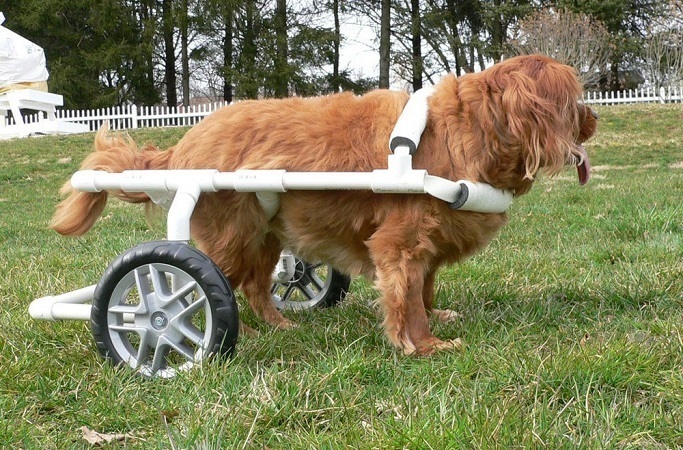
DIYDogWheelchair.com
DogsAholic.com published a post on designing this easy-to-make PVC pet wheelchair.
Start by building the top frame with the PVC pipe, using the tee connectors to create a U-shaped top frame with the tubing.
Use tees at the front end of the pipe. Slip a material through both ends of the pipe. Form a harness that fits across the shoulders and chest of your dog. Cut the pool noodle and use it as padding for your harness, as described in the image above.
Use elbow tees to form the rear frame for the wheels. You can drill holes onto the elbows at the bottom and attach the wheels, so they spin freely. Connect the rear wheels with a wide rear axle made from PVC and more elbow tees.
Finish off by creating the rear sling using the same method of pulling fabric through the tee connectors, as you did for the front harness.
Tools You'll Need:
- Hacksaw or PVC pipe cutter
- Cordless power drill
- Measuring tape
- Sewing needles and thread (preferably nylon for strength)
- Scissors
- Pen
- Mallet or soft head hammer
Materials Required:
- 10-ft PVC piping
- 4 x PVC elbow joints
- 2 x PVC Tee connections
- 2 x furniture casters or dolly wheels
- 2 x C-clip
- PVC epoxy glue
- 1 x foam pool noodle
- Ace bandages
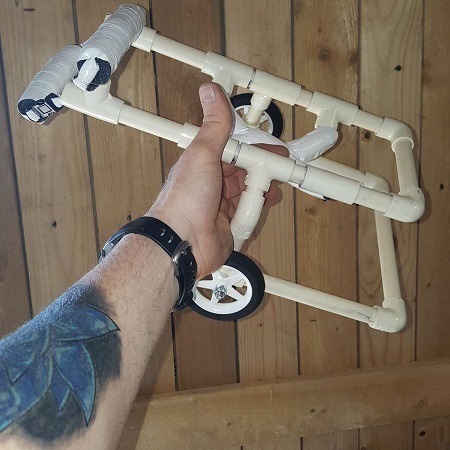
DIYDogWheelchair.com
2. PVC DIY Sling Quad-Style Wheelchair
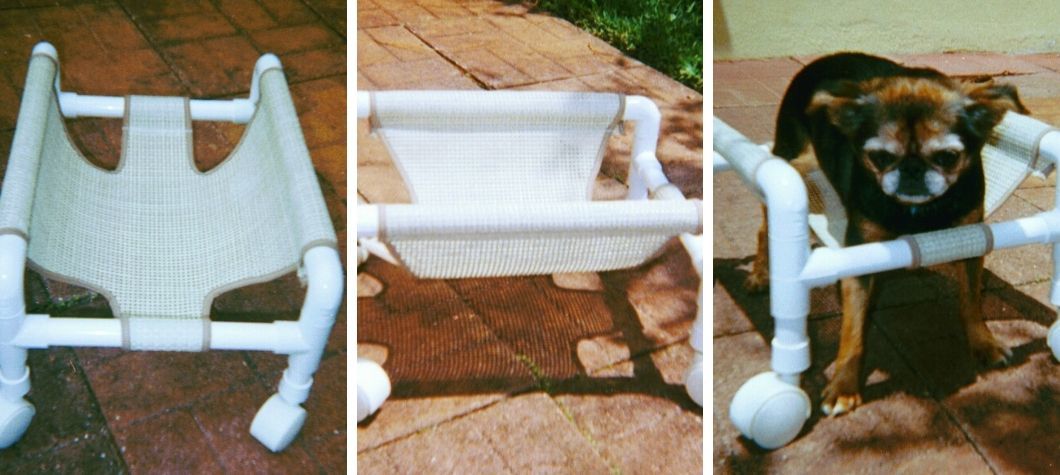
HandicappedPets.com
If your pooch has weak front and rear legs, then you’ll need to build them a quad-style wheelchair like this one, courtesy of HandicappedPets.com to provide even support to the front and rear legs of your dog. Quad chairs provide the best support, and they’re commonly used post-surgery, or for senior dogs that are experiencing a decline in skeletal and joint health.
The chair is easy to build, but some people might find fitting the sling to be a bit tricky.
After taking your measurements, form 2 x U-shaped frames for the top and bottom of the wheelchair. Use elbows on the top frame, and tees on the bottom to connect both frames.
At the rear of the chair, you’ll fit your axle through the PVC tubing, connecting to two large wheels. On the front, you mount casters. The casters allow your pooch to turn easily, without the need to draw a large turning circle with the chair.
Finish off your design by fitting a sling at the rear and over the chest. Allowing your dog to take a seated position in the chair while walking.
Tools You'll Need:
- Hacksaw or PVC pipe cutter
- Pair of scissors
- Measuring tape
- Pen and needle
Materials Required:
- PVC Piping
- 4 x PVC elbow joints
- 1-yard of durable and comfortable fabric
- 2 x large PVC thread rear wheels
- 2 x PVC thread caster wheels
3. Most Affordable DIY Dog Wheelchair

We picked this example up from Reddit. It’s a wheelchair that’s ideal for medium to large-size dogs and the most affordable design out for the 5-models in this review.
You can put this wheelchair together in an hour or two and take Fido out for a walk in his new chair before the end of the day.
After taking your measurements, cut two vertical lengths of PVC pipe for the wheel forks.
Fit the wheels to the bottom of the PVC and attach using the threaded bar and nuts, as shown above.
Construct the frame with the piping, using the elbows to form the frame and handle, and the tee connectors to build the wheel forks and guide handle.
Gluing everything together is optional. Fit the nylon web sling to the frame and secure it in place.
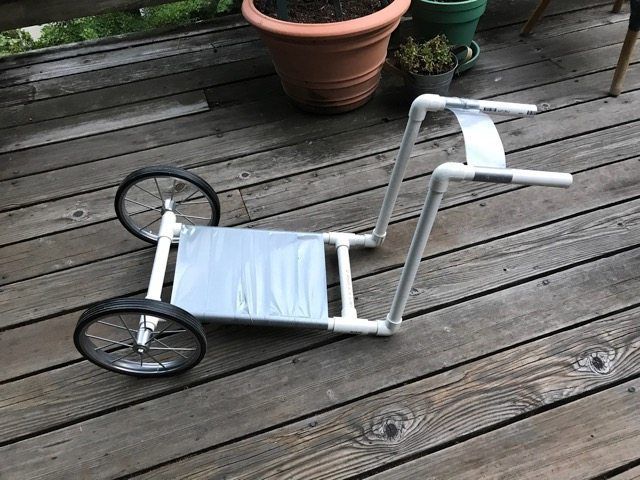
Tools You'll Need:
- Hacksaw or PVC pipe cutter
- Pair of scissors
- Measuring tape
Materials Required:
- PVC Piping
- 4 x PVC tees and elbow joints
- PVC glue (optional)
- 2 x Rollerblade wheels
- Threaded bar to build axles
- Material for the sling (nylon webbing is our top choice)
4. 3D-Printed DIY Dog Wheelchair
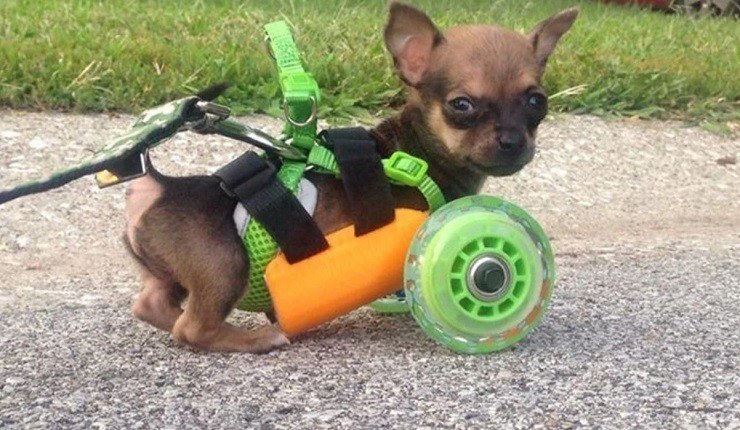
The Downtown Vet
This tiny pup lost his front legs at birth, but he looks adorable in this custom-built quad wheelchair. 3D-printers are amazing pieces of technology, and you can use them to print anything you want, from facemasks to wheelchairs.
Visit Makezine.com for these wheelchair plans. You can download them from the site and use them in your 3D printer application. These plans have a different take on wheelchair materials, changing out the PVC piping for acrylic tubing.
If you know someone that has a 3D printer, ask them to help you out. There are also plenty of 3D printing businesses that might be willing to help you with printing your doggie’s wheelchair for free if you pull on their heartstrings.
We couldn’t find any assembly instructions with these plans, but we assume it’s a straightforward process. The hard part is printing the chair. While this design is best for small dogs, you can scale it and use it for large breeds as well.
However, it might be expensive having someone else print you a larger chair.
Tools You'll Need:
- 3D Printer
- Hacksaw
- Measuring tape
- Pen
Materials Required:
- Acrylic tube
- Rollerblade or skateboard wheels
- Plastic connectors for the straps
5. Aluminum Dog DIY Wheelchair
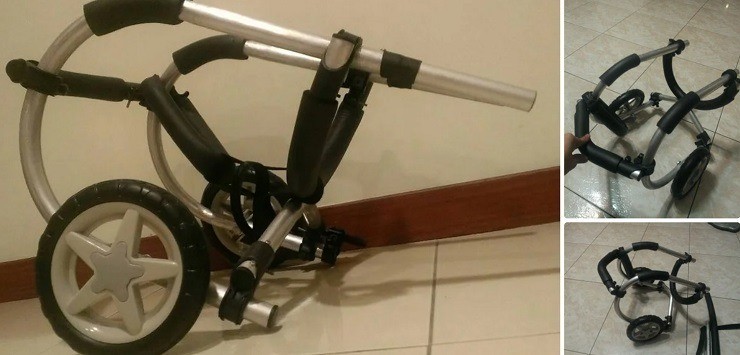
If you want a durable wheelchair for larger breeds, then we recommend investing in aluminum tubing for your dog wheelchair frame like the one used in Instructables (image above).
Working with tubing requires specialist bending equipment, so you’ll need to use a contractor or metalworker to bend your tubing for the frame.
Therefore, you must ensure that your measurements are exact. After the metalworker bends the tubing, there’s no going back if you make a mistake with your measurements.
This design comes from DoggyWheels.Blogspot, and it’s an example of a high-quality wheelchair that’s effective, lightweight, and durable.
A word to the wise, when logging onto this site, you’ll see a picture of the owner’s dog after she was put to sleep by the vet. It’s not a shocking photo or anything, but it might catch you by surprise.
Still, it points to the seriousness of immobility in dogs, and the consequences of not building a wheelchair to let your furry friend enjoy their final days.
The plans for this chair are reasonably straightforward, and bending the tubing it the challenging part. Once that’s over, the rest of the assembly is relatively easy.
This chair offers a seated sling, connecting to the rear and top of the frame. The support bar at the bottom and top of the frame provides sturdy support suitable for large, heavy dogs. We use pram wheels for this wheelchair design, as they provide plenty of mobility and don’t catch on rocks or uneven ground.
This metal design can damage your furniture around the house.
Your dog doesn't understand the need to draw large turning circles, and there's a chance they will bump into things as they get used to managing the chair.
Therefore, we recommend you use some foam tubing over the corners of the frame to provide anti-scratch protection for your home and furniture.
Tools You'll Need:
- Metal blades for your hacksaw
- Mallet
- Sharpie
- Measuring tape
- Needle and nylon thread
- Steel tubing
Materials Required:
- 2 x 48-inch length aluminum tubing or CR steel tubing
- 2 x Large pram wheels
- 2 x Threaded axles
- Metal bonding adhesive
- Threaded lock bolts and nuts
- Snap-hook
- Piping insulation
- Denim for the sling
- Velcro straps
- Sand to fill the frame if necessary
- Nylon thread
Wrapping Up - Give Your Canine Pal a Second Chance at Enjoying Life
It’s a tragic sight to watch a dog struggling to walk due to old age, bad hips, or a severe injury that leaves them without one or more of their limbs. However, you can give your pooch a new lease on life with one of these five wheelchair designs.
You don’t need to go to the expense of buying a pre-made chair. Most of these designs are easy enough to put together in an afternoon.
By using one of these DIY designs, you could save yourself more than $100 on the chair, depending on the type of materials you use in fabrication.
A wheelchair provides your pooch with the mobility they need to start enjoying life again. Dogs love going for a walk, and they’ll wear themselves into the ground with their enthusiasm.
By giving them the support of a wheelchair, you ensure they don’t damage their joints, further minimizing the risk of failure in the affected legs.




how to make
DIY PVC pipe wheel chair front legs